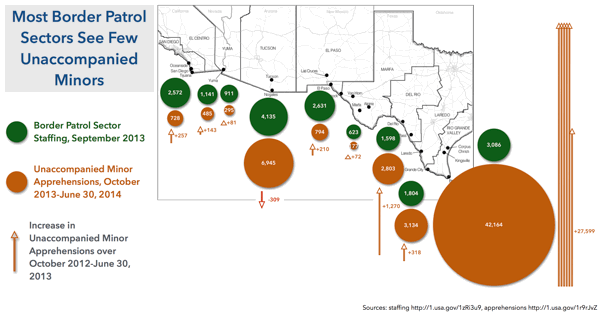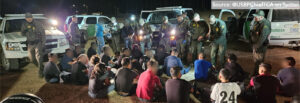Spending even more on border security, or sending the National Guard, will not resolve the unaccompanied minors crisis
Many in Congress are calling for large funding increases to secure the border, to make the border “operationally controlled,” and to deploy the National Guard. These security proposals make up half of the text of the “HUMANE” Act, introduced by Sen. John Cornyn (R-Texas) and Rep. Henry Cuellar (D-Texas), which is designed to drastically hasten the deportation of children seeking refuge at the U.S. border.
More funding to seal the border is the wrong course of action. Funding for Border Patrol alone has more than doubled since 2005 [PDF]. There are already enough Border Patrol resources at the U.S.-Mexico border. Congress does not need to add more: Customs and Border Protection needs to distribute them to respond to the current situation. We absolutely do not need to take the drastic step of a new National Guard deployment.
It is important to remember that the children fleeing violence in Central America are not evading U.S. border security. They are turning themselves in to agents at the border, as they seek refuge in the United States. More funds to secure the border will not address this.
The urgent funds of the President’s supplemental appropriations request are needed to process and protect unaccompanied minors at the border according to standards in U.S. and international law; and to ensure that these children are not sent back to become victims of horrendous community-level violence.
The so-called “surge” in Central American migration is concentrated in only one of the nine sectors into which Border Patrol divides the U.S.-Mexico border. Agents assigned to the Rio Grande Valley sector, in south Texas, are reportedly overwhelmed by the need to accommodate and process the wave of unaccompanied children. Agents are spending so much time processing the arrivals that they are dedicating fewer man-hours to regular patrols to interdict drugs and other illegal cross-border activity.
In the other eight Border Patrol sectors–central and west Texas, New Mexico, Arizona, and California–the situation is far different. Except for modest increases in unaccompanied minors, numbers of border crossers are at or near 40-year lows. Ratios of apprehended migrants per agent are a small fraction of what they are in south Texas.
Though the flow of new migrants is lopsided, Border Patrol agents are evenly distributed across the border. The busy Rio Grande Valley sector has only slightly more agents than far quieter San Diego and El Paso, and many fewer than Tucson.
Border-wide, the number of Border Patrol agents doubled between 2005 and 2011; today there are over 21,000 [PDF]. Congressional proposals call for increasing this still further. These proposals include Section 205(c) of the “HUMANE” Act.
This is an inappropriate response to arrivals of children who do not seek to avoid U.S. authorities, but in fact “chase them down” to turn themselves in. An across-the-board increase in Border Patrol capacity, meanwhile, adds much unnecessary cost. Border Patrol has the personnel and resources–they just happen to be located far from where the children are arriving.
One answer might be a temporary transfer of Border Patrol personnel from other sectors to deal with the influx. At least 100 agents have been transferred to the Rio Grande Valley in 2014. This is admittedly difficult. Border Patrol is a civilian force. Its agents can’t be deployed at a moment’s notice like soldiers. Agents don’t live in barracks: they live in communities where they have mortgages and kids in school.
Instead of further border-wide increases, the Department of Homeland Security needs to improve Border Patrol’s ability to respond to rapid geographic shifts. In the past 20 years, we have seen the epicenter of undocumented migration–what the HUMANE legislation calls “High-Traffic Areas”–shift from El Paso and San Diego to Arizona, and now to south Texas. A buildup in south Texas will probably move the problem elsewhere in a few years, overwhelming another Border Patrol sector while the rest of the border remains calm. This has become a pattern, and Border Patrol needs to be able to adjust to it more nimbly without having to grow each time it happens.
Likewise, a new National Guard deployment, which Section 205(d) of the “HUMANE” Act would authorize, is highly inadvisable. Two large National Guard deployments since 2006 have proven very costly and yielded little more than an additional ability to observe the border–an ability that Border Patrol and CBP have since largely developed on their own. The last deployment, Operation Phalanx, helped Border Patrol apprehend 25,514 migrants at a cost of US$160 million, or US$6,271 each.
More importantly, even if federally funded Guardsmen are at the command of governors, they are still soldiers. As south Texas Border Patrol agents are drawn away by unaccompanied minors, the “HUMANE” Act and House Republicans’ proposal would substitute them not with agents from elsewhere, but with a measure that is rare in our democracy: military personnel carrying out a law enforcement mission on U.S. soil.
Law enforcement in America’s border zones is a civilian function. Sending combat-trained soldiers to fulfill this function is inappropriate. The “HUMANE” bill, as currently drafted, would place soldier-police in frequent contact with U.S. citizens, including at tense situations like road checkpoints and apprehensions in remote areas. It would also increase their ability to carry out surveillance of U.S. citizens on U.S. soil.
Authorizing such a mission is a weighty step with only a handful of precedents since the Posse Comitatus Act became law in 1878. We must not take it lightly or in an open-ended way. As another civilian option exists–reconfiguring Border Patrol’s large but mismatched presence at the U.S.-Mexico line–a National Guard deployment is neither a cost-effective nor an institutionally sound option.
The reporting, measurement, and transparency requirements proposed in the “HUMANE” legislation (Sections 202 and 203) are worthwhile. It is stunning that no inter-agency Southwest Border Security Strategy document exists today. And any measures that encourage Customs and Border Protection to be more forthcoming with data and evaluation measures are welcome and overdue. In this era of “big data,” it is well past time for Congress and the public to have greater access to recent information about results and activities, including apprehension rates, drug seizures, capabilities, inter-agency coordination, and the effectiveness of measu
res put into place by the past decade’s large border-security buildup.
However, the proposed strategy document’s emphasis on unmanned surveillance technology raises important issues of privacy and civil liberties, as well as cost-effectiveness. A Predator-B drone operating along the border, GAO reported in 2011, costs at least US$3,234 per hour to operate, with results that have yet to be properly evaluated.
The HUMANE bill and other statements from members of Congress call for funds to guarantee a “secure border” in which U.S. agents have “operational control.” But they underestimate how much that would truly cost. The U.S. government should keep spending on border security increases, the HUMANE bill suggests, until Border Patrol can catch at least 90 percent of all illegal crossers, in all nine border sectors.
In 2011, the last year for which such a statistic is publicly available, only [four of nine sectors][10] met this standard. The record may be worse now: there are more migrants than in 2011 due to an increase in Central American arrivals (including adults), and new technologies may be detecting more un-apprehended border crossers in remote areas.
Adherence to this too-high 90 percent standard could condemn the U.S. government to a spiral of increasing costs with little added benefit. Instead, scarce resources should be put to work where they are most urgently needed: in guaranteeing that immigration judges have the manpower and resources to consider Central American children’s pleas for protection. New funds will allow them to decide their cases as quickly as possible without weakening the protections provided by the 2008 Trafficking Victims Protection Reauthorization Act. This is the best possible outcome for the tragic situation at the border.


